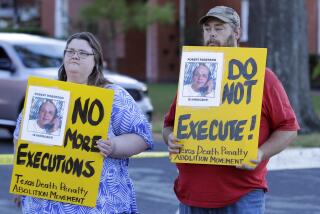Justices Deal Setback to Right-to-Die Movement
- Share via
SAN FRANCISCO — Family members may not withdraw feeding tubes from conscious but severely brain-damaged loved ones unless they clearly show that the patient would have wanted to die, the California Supreme Court held Thursday.
The unanimous ruling was a blow to the right-to-die movement and a defeat for the California Medical Assn. It will probably affect thousands of patients, including Alzheimer’s and stroke victims, who are conscious but unable to communicate their wishes. Tens of thousands of such patients linger in hospital beds nationwide.
Unless these patients have left specific written instructions or designated a surrogate decision maker, their legal conservators may not remove life-sustaining tubes without “clear and convincing” evidence that they would have wanted to die or that death would be in their best interest, the decision said.
Life support still can be withdrawn from people who are unconscious--in a vegetative state or a coma--without clear evidence of their wishes. The decision affects those who retain consciousness but have little, if any, awareness of their environment.
Lawyers in the case said the ruling should encourage Californians to leave written instructions about their wishes or to appoint a surrogate to make decisions for them. Surveys now show that fewer than 20% of people take such precautions.
“The bad news is for the vast majority of people who haven’t done that, it is not going to be enough for them to have had informal oral conversations with their loved ones about their end-of-life wishes,” said attorney Jon B. Eisenberg, who represented six health care organizations and 43 bioethicists in the case.
Eisenberg said the decision also may make doctors feel vulnerable legally if they consent to a family’s wishes to discontinue life-sustaining treatment.
Susan Penney, a lawyer for the California Medical Assn., said the ruling “will result in a lot of futile medical treatment that in all probability the patient would not have wanted.”
For all the ruling’s impact, it will have none on the case argued before the high court. That’s because the subject of the case, Robert Wendland, died of pneumonia a few weeks after the court heard arguments in his case.
Lawyers for the litigants asked the Supreme Court to decide the case anyway to clarify the law for families in similar situations.
Wendland, 49, was severely brain-damaged in a vehicle accident in 1993 and could not talk, walk, eat or express his wishes. His wife, Rose Wendland, his children and his brother said Robert would not have wanted to be kept alive under such circumstances.
But Robert’s mother, Florence Wendland, 78, contended that Robert would have chosen life over death. Janie Hickok Siess, her lawyer, praised the ruling Thursday.
“It is going to save a lot of lives,” she said. “I just wish Robert were here for this.”
A generation ago, starting with the celebrated case of Karen Ann Quinlan, courts ruled that families could remove life support from patients who were comatose or otherwise permanently without consciousness.
Robert Wendland was different. He was considered minimally conscious, capable of responding to simple commands but unable to communicate. His wife said he was a “shell” of his former self.
A judge in Stockton ruled in 1995 that Rose Wendland, whom he appointed Robert’s legal conservator, could not pull his hydration and feeding tubes because she had failed to present clear and convincing evidence of Robert’s wishes. A Court of Appeal overturned that decision.
Justice Kathryn Mickle Werdegar, writing for the Supreme Court, said Thursday that the Stockton trial judge was correct. She noted that no other court in the nation has allowed conservators to remove feeding tubes from patients who were conscious.
The court’s opinion changed a 1999 California law that allowed conservators to withdraw feeding tubes from conscious patients if there was a preponderance of evidence that the patients would have wanted to die.
The court said such a standard of proof would violate a person’s constitutional right to life. The court also reasoned that the Legislature may not have been aware of the legal standard under the law.
Werdegar said it is possible that a conscious but uncommunicative patient “might perceive efforts to keep him alive as unwanted intrusion and the withdrawal of those efforts as welcome release.
“But the decision to treat is reversible,” she wrote. “The decision to withdraw treatment is not.”
Videotapes of Patient Viewed
Werdegar cited a new state law that allows patients to tell their doctors whom they would want to make decisions for them should they become incapacitated. The law, she said, “gives competent adults extremely broad power to direct all aspects of their health care in the event they become incapacitated.”
In Conservatorship of Robert Wendland, S087265, Rose Wendland “offered no basis” for terminating his life support “other than her own subjective judgment that the conservatee did not enjoy a satisfactory quality of life and legally insufficient evidence to the effect that he would have wished to die.”
Werdegar also noted that the court had reviewed videotapes of Robert Wendland.
“At his highest level of function between February and July 1995, Robert was able to do such things as throw and catch a ball, operate an electric wheelchair with assistance, turn pages, draw circles, draw an ‘R’ and perform two-step commands,” the court quoted from a medical report.
Lawrence J. Nelson, who represented Rose Wendland, said the court misunderstood her husband’s true condition. Wendland’s wife and children said he never recognized them after the accident, and one medical expert said it was doubtful that Wendland had the capacity to experience joy, Nelson said.
Nelson called the ruling a “retrograde decision” that is going “to force a lot of suffering on people.”
He particularly objected to the wording of the ruling, describing it as “insulting” to Rose Wendland and “hostile.”
“It is as if she hadn’t been married to this guy for over 20 years and lived with him and bore his children and knew him inside out,” said Nelson, a professor of philosophy at the University of Santa Clara who represented Rose Wendland free of charge.
Other analysts agreed with his assessment of the ruling’s tone.
“It’s a little bizarre,” said George Annas, chairman of the health and law department at Boston University School of Public Health and the author of a book on patient rights.
“They talk about his wife wanting to end his life rather than refusing treatment, and they seem to treat hydration and nutrition tubes as unique types of medical treatment,” Annas said.
James M. Braden, who represented Robert Wendland in the case, said the Legislature was trying to ease the legal hurdles in such termination-of-treatment cases and was aware of Robert Wendland’s situation when it passed the law in 1999.
“The impression is that the standard of proof was buried somewhere in a 280-page report that maybe the Legislature didn’t read,” said Braden, who was persuaded that Wendland would have wanted to die. “It was approved by the Legislature.”
University of Santa Clara law professor Gerald Uelmen, who has followed the case, said the court was “opting in favor of a higher threshold when life is at stake, and I frankly think that was appropriate.”
He said some families may be able to offer clear and convincing evidence based on statements their loved ones had made. “But it would have to be unambiguous and in a context that leaves little doubt as to intent,” he said.
USC law professor Erwin Chemerinsky said the ruling appeared “insensitive, to put it mildly, toward the wife.”
“This court doesn’t seem at all sympathetic to the claims that were involved here and went out of its way to interpret the statute restrictively,” he said.
Vincent Fortanasce, a neurologist who was an expert for Florence Wendland, said the court adopted the right standard for situations when a life is at stake.
“The impact of this decision is that a number of people who are disabled will not have to fear that HMOs and managed care will be able to make decisions about them without it clearly being in their best interest,” he said.
J. Clark Kelso, a McGeorge School of Law professor, said the high standard set by the court was correct because it applies to court-appointed conservators, not someone selected by the patient.
More to Read
Sign up for Essential California
The most important California stories and recommendations in your inbox every morning.
You may occasionally receive promotional content from the Los Angeles Times.











